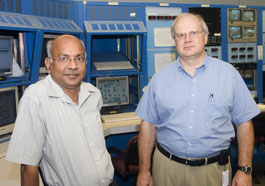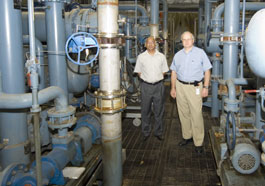
Jefferson Lab's Deputy Cryogenics Group Leader Venkatarao (Rao) Ganni (left), and Cryo Group Leader Dana Arenius pause in the Central Helium Liquefier control room.
The Cryogenics Group in the Accelerator Engineering Department of the Accelerator Division is tasked with providing refrigeration for a variety of Jefferson Lab research activities. Three refrigerators provide -452 and -456 degrees Fahrenheit refrigeration for the operation of the Continuous Electron Beam Accelerator Facility and its three experimental halls, the Free-Electron Laser Facility, and the Superconducting Radio Frequency Test Facility.
Using their extensive experience in the industrial design of cryogenic systems, group members have designed a new process that revolutionizes the way cryogenic plants work. Although the benefits of the process are fully realized for new plants, portions of the new process have already been applied to existing plants, resulting in substantial savings in electricity costs at several Department of Energy research facilities. Jefferson Lab, Brookhaven National Lab's Relativistic Heavy Ion Collider and the Spallation Neutron Source at Oak Ridge National Lab have all benefited from the innovation through cooperative collaborations, and now other facilities are expressing interest in implementing the process in their facilities.
Keeping Cool
Jefferson Lab's refrigeration system uses a continuous closed cycle very similar to that of a home air conditioner. Instead of Freon, helium is used as the refrigerant. It is first sent through a series of compressors.
"When you compress helium, it gets warmer. You cool it down with water and then further cool it down with liquid nitrogen," says Will Oren, Head of the Engineering Department in Jefferson Lab's Accelerator Division. The high pressure helium gas then drives turbines, making it even colder until the helium gas finally turns into a liquid at a temperature of -452 to -456 degrees Fahrenheit. As the liquid helium is used to cool the superconducting accelerator cavities and other equipment at the Lab, it boils back into a gas and begins to warm up. At this point, it's sent back through the system to start the cool-down process all over again.
Pressure
One atmosphere of pressure is the amount of pressure felt at sea level at the same latitude as Paris, France. It equates to just over 14.5 pounds per square inch. For comparison, a car tire may be inflated to about 32 pounds per square inch, a little more than two atmospheres of pressure. The compressors in the Central Helium Liquefier can compress helium from one atmosphere to between 16 and 21 atmospheres, equating to a pressure of 235-309 pounds per square inch.
Cryogenics Group Deputy Leader Venkatarao (Rao) Ganni says that of all the components in the system, the compressors use the largest amount of electricity. "We use very large helium compressors, which compress helium from about one atmosphere up to 21 atmospheres. These compressors use a lot of electrical power," he explains. (For more about pressure, see sidebar.)
Ganni says helium refrigerator manufacturers didn't always consider the daily variations in a client's needs when designing a plant. Instead, refrigerators were made to operate at maximum efficiency when at the full refrigeration design capacity or, at best, a few intermediate operating points. "In industry, we were asked by our customers to guarantee this maximum capacity, although that operating point is normally higher than the daily operating needs," Ganni says.
For instance, when less refrigeration was needed in the past, the same amount of helium was sent through the compressors at full operating pressures; therefore, the compressors were using the same amount of electricity, even when full refrigeration capacity wasn't needed. Cryogenics Group Electrical Lead Jonathan Creel notes, "It's like driving your car everywhere with the gas pedal all the way down while controlling your speed with the brake pedal, even if you only need to go ten miles an hour."
Ganni says the new process takes a different approach. He says the brake is removed and the speed is now controlled by only the gas pedal.
Jefferson Lab's Continuous Electron Beam Accelerator Facility uses superconducting niobium cavities to accelerate electrons for nuclear physics experiments. Niobium is superconducting, having close to zero electrical resistance, at cryogenic temperatures. Jefferson Lab routinely cools niobium to between -452 and -456 degrees Fahrenheit. This extremely low temperature requirement is met with liquid helium.
Cryogenics is the science of the very cold, which includes temperatures below -292 degrees Fahrenheit.
Removing the Brake
Ganni and his colleagues implemented a new philosophy to manage the cryogenic refrigeration system capacity. They reconfigured the refrigeration system controls to efficiently scale back the compressor energy consumption by reducing the operating pressures when full capacity isn't needed. When more refrigeration is required, the system controls then ramp the system pressures back up.
"We refer to this portion of the process as Floating Pressure. When applicable portions of the new cycle are applied to existing plants, we regulate the compressor discharge pressure to match the refrigeration load," Ganni explains. The discharge pressure is the amount of compression the compressors apply to the helium (usually 16-21 atmospheres, see sidebar).
Ganni says the new control system senses when more refrigeration is needed by monitoring the amount of helium being used for cooling. "The pressure floats to meet the load. If there's no load, the pressures will come down, the power going into the motor will come down, the electricity use will come down," he iterates.
"We've actually been able to turn down these compressors to the level where they're providing the correct amount of refrigeration for a given load," says Dana Arenius, Cryogenics Group Leader. He says this different mode of operation, dubbed the Ganni Cycle, has made the refrigeration plant much more efficient.

Venkatarao (Rao) Ganni, deputy Cryogenics Group leader (left), and Dana Arenius, Cryo Group leader, stop for a moment while walking through the refrigeration plant's main compressors.
The portions of the Ganni Cycle which can be used for existing plants have slashed the power requirements of the Jefferson Lab's refrigeration system, while still meeting the Lab's needs. The cycle has dropped the electricity required for Jefferson Lab cryogenics from 6 Megawatts (MW) to 4.2 MW, resulting in a direct savings of $33,000 each month in electricity costs.
What's more, Arenius says implementing the new cycle didn't require a lot of new equipment. As implemented at several existing facilities, the cycle required very few or no new components. "It uses the same equipment. However, what it does change is how it's controlled and how it's configured," he says.
The Ganni Cycle also nearly doubles the lifetime of some refrigerator components, increasing the time between necessary maintenance periods. "Industry standards would indicate that you have to tear down a compressor for a complete rebuild after a maximum of 45,000 hours of operation. At Jefferson Lab with the Ganni Cycle, the number of hours before required compressor rebuild is around 74,000 hours. So we're gaining a factor of just over 1.7 more running time without having to do repair or maintenance. And that is a substantial savings in manpower and spare parts," Arenius notes. In addition, the system runs more reliably, has more availability, has improved stability and runs more efficiently.
The group is also looking forward. Group members theorize that incorporating the Ganni Cycle into designs for the next generation of refrigeration systems will make the technology even more efficient. "It's an intellectual process, but it sets the pattern for how you design the hardware. It'll produce a higher-efficiency plant which will lower operational costs," Creel says.
Ganni agrees. "It costs you less -- costs less capital, consumes less power, and the system is more reliable. If you have a more efficient plant, you need less hardware," he says.
But What Is It Really?
It's a well-thought-out cycle. It's a new arrangement of the equipment that is designed to maximize efficiency, according to Ganni and Creel.
Ganni points out that the innovation was made possible by his and his colleagues' experience in industry before coming to the Lab and in his supervisor's willingness to try something new. "It takes very specialized people to figure out how to get the machine to turn down, because the compressors weren't originally designed for that purpose. You need to know what the [operating] envelope of each piece of the machine is," he says.
Sharing the Bounty
The money savings realized with the Ganni Cycle is having an impact at the Lab. The Cryo Group used some of the money to revitalize the refrigeration plant's charcoal beds and to conduct other cost-saving maintenance and efficiency improvements. (Charcoal beds are used to purify the helium. They remove oil that's added to the helium during part of the refrigeration process).
"We are taking less money to run the refrigerators. We gained more physics out of it, because we turned that savings around to work more efficiently. So you're getting more physics in an indirect way," Oren says.
Portions of the Ganni Cycle have also been implemented at other Department of Energy (DOE) facilities for existing plants. In a cooperative energy savings collaboration with Jefferson Lab, the Brookhaven National Laboratory, located in Upton N.Y., initiated a program to upgrade the Relativistic Heavy Ion Collider (RHIC) cryogenic system where portions of the Ganni Cycle were applied to help increase the efficiency of the helium liquefier. The collaboration reduced the refrigerator electric power consumption by 35 percent, from 9.2 MW to 6 MW. The RHIC staff has also reported an increase in system stability and reliability. At the Spallation Neutron Source at Oak Ridge National Lab in Oak Ridge, TN, a similar collaboration centering on optimizing the 2K (Kelvin) helium cryogenic plant operation led to a 32 percent electric power reduction, from 3.8 MW to 2.6 MW.
The process behind the Ganni Cycle has been submitted to the U.S. Patent Office for review, and a patent is pending. In addition, the group has also fully automated Jefferson Lab's refrigeration facilities, using a computer-based control system for round-the-clock load-matching efficient operation, without the need for round-the-clock staffing.
Jefferson Lab's Cryogenics Group operates and maintains the Central Helium Liquefier, the world's largest 2-Kelvin refrigerator. Other facilities operated by the group are the End Station Refrigerator (ESR), which supports cryogenic needs in all three of Jefferson Lab's experimental halls, and a Cryogenic Test Facility, which supports accelerator component research and development.

Jefferson Lab's Cryogenics Group includes: back row (left to right) Scott Thompson, Kelly Dixon, Ernie Ernsting, Brian Murphy, Dan Oprisko, Jon Barbour, Tom Reid, Pat Williams and Garry Justice; middle row (l. to r.) Isaac Snowburg, Bill Hunewill, Mat Wright, Pete Knudsen and Group Leader Dana Arenius; and front row (l. to r.) Tom Slachtouski, Ann Hageman, Buddy Carlton, Mark Stapleton, Rao Ganni, Jonathan Creel and L.T. Yarrington. All photos by Greg Adams, JLab.
Editor's Note: Many thanks to Rao Ganni, Dana Arenius, Jonathan Creel, Will Oren, Mat Wright and Hari Areti -- all contributed directly to this story.

